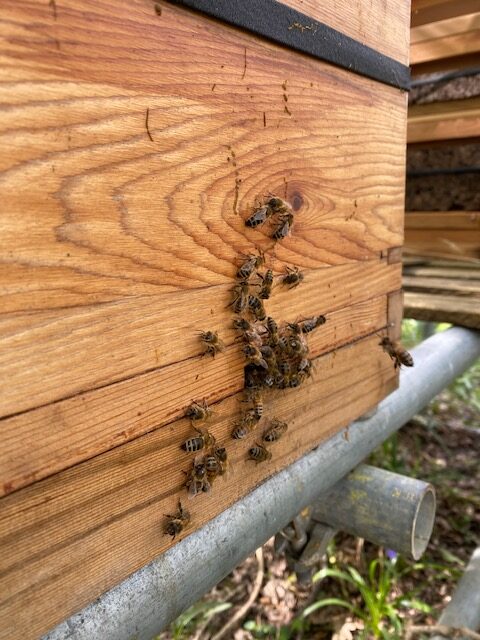Your basket is currently empty!

Beekeeping for varroa resistance
Posted by:
|
On:
|
Beekeepers with varroa resistant colonies have stopped treating those hives with miticides to control the Varroa destructor mite, instead allowing adapted bees to manage the populations themselves.
Here at Estelle Hives, we’re passionate about varroa resistant beekeeping, believing it to be the only sustainable way forward. We know from experience that it is possible, and we are backed by a growing catalogue of scientific research and the experiences of other beekeepers who are keeping varroa resistant colonies across the UK.
A book could be written on the subject, and indeed it has. If you already keep varroa resistant bees or you are interested in letting your bees manage varroa without having to resort to miticides, then we would urge you to read The Honey Bee Solution to Varroa by Steve Riley, a peer and mentor at Westerham Beekeepers. We’d also recommend bookmarking https://www.varroaresistant.uk/.
Varroa is thought to have arrived in the UK in the early 1990s, having gradually spread out of Asia. It caused huge numbers of colony losses in those early days. After initial reluctance from beekeepers, applying miticides to hives became the almost universal norm. It was a case of controlling the mite or facing the loss of the colony in no more than three years as viruses vectored by the mite left colonies diminished and depleted.
But nature took its course and bees began to evolve and adapt, free-living colonies in the UK starting to survive by managing the mites themselves. This evolution had been seen in both wild and managed colonies in countries like Cuba, which had no access to the miticides.
Worker bees learnt to detect the odour coming from an infested worker cell, uncapping the cell and either chewing out affected larvae, or recapping the cell. This disrupts the breeding cycle of the mites and means that the mite population cannot reach a threshold that puts the colony at risk of demise. That’s exactly what miticides do – keep mite populations below a threshold without being able to eradicate them completely. Surely the bees doing this naturally is a better option? We certainly think so.
How do you know if you can go treatment free? Well, our first bit of advice is that it unadvisable to go cold turkey and just stop treating. You must have bees that can manage varroa themselves already, or can learn to do it themselves over time (five years or more). To know this, you’ll need to be able to monitor for mite populations and be able to spot the traits that we’re seeing in our colonies of varroa resistant bees:
- Do some colonies have consistently lower mite counts on the bottom or sticky boards than other colonies?
- Are you seeing white pupal exoskeleton parts on the board?
- Are you seeing uncapped pupae at the pink-/purple-eyed stage during your inspections and evidence of cratered, re-capped cells?
If you are seeing these traits, then this is a colony that might be able to manage varroa themselves and you might consider stopping miticide treatments. You’ll need to continually monitor mite numbers and be aware of the seasonal flow in mite drop counts and the traits, and be prepared to see less of the traits during certain times of year like the main nectar flow. You’ll then need to isolate the colony or keep it alongside other treatment-free colonies and use it to raise more resistant stock, replacing the colonies that can’t manage varroa over time.
We now have several colonies that are varroa resistant and successfully so, and we are using those to raise new queens that will either re-queen colonies that aren’t successfully managing varroa themselves or to see if they can raise new varroa resistant colonies. We’re not alone in this. You can read the experiences of several of the varroaresistant team on the site.
One of the big issues for varroa resistant beekeeping in the UK is the lack of availability of varroa resistant queens and nucs to buy. One day, we may be part of the solution for that, but that’s in the future for now. In the meantime, we’re growing our own stock and hopefully also helping the stock in the wider area by sending out drones from varroa resistant colonies which can spread the genes of the successful queen lines.
Here’s why we think this is the sustainable way forward for UK beekeeping:
- We now know that bees in the UK have evolved to manage varroa themselves, which is far preferable to adding invasive chemicals and treatments to hives.
- Managing varroa using chemical treatments has been done for 30 years or more and the mites have shown to become resistant to some of the treatments. This is not a sustainable way to support what is a managed, but wild, insect.
- A far better way to support managed colonies of bees would be to encourage and support the proliferation of the varroa-resistant genetics, negating the use of treatments over time and strengthening the gene pool and resilience of the wider British bee population.
